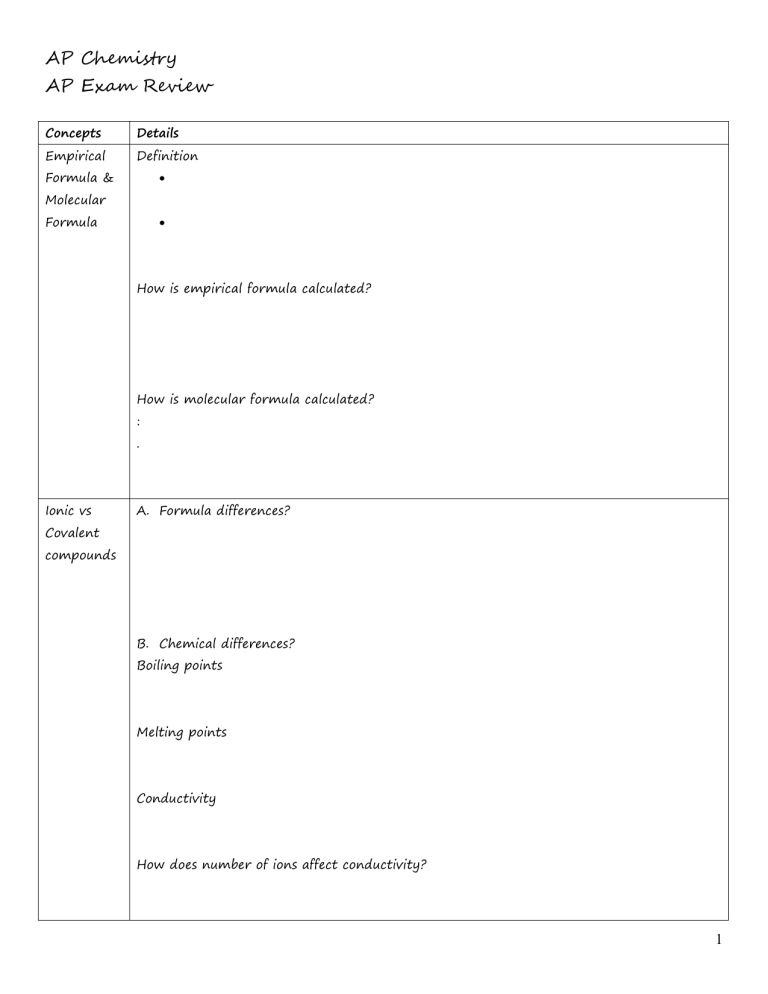
AP Chemistry AP Exam Review Concepts Details Empirical Definition Formula & Molecular Formula How is empirical formula calculated? How is molecular formula calculated? : . Ionic vs A. Formula differences? Covalent compounds B. Chemical differences? Boiling points Melting points Conductivity How does number of ions affect conductivity? 1 AP Chemistry AP Exam Review Density Definition: Changes with changes in ___________________ Lattice Definition: Energy in ionic compounds Coulombs Law: Relationships: Bond Compare single – double – triple bond strength. Energy in Covalent Compounds How does this relate to bond length? How can H be calculated for a reaction using bond energies? Molarity What is Molarity? What will the final concentration KNO3 when 400 mL of 1.8 M Ba(NO3)2 solution reacts with 300 mL of a 1.2 M K2SO4 solution? 2 AP Chemistry AP Exam Review Gases What variable affects: Molecular speed Density Effusion What is partial pressure? STP? When should it be used? What is your go to equation for gases? Electron Configuratio Write a sample electron configuration for the following: A noble gas A transition metal A chemically unreactive element An element with 1 valence electron in the p block An element with an electron in an excited state. A halogen Two unpaired electrons ns How are valence electrons identified in an electron configuration? 3 AP Chemistry AP Exam Review Periodic All periodic trends are best explained by atomic radius, quantum levels, the effective Trends nuclear charge of the nucleus and the shielding of the core electrons. Use these principles to explain: The difference between 1st ionization energy for Potassium and Rubidium The difference between 1st and 2nd ionization energy in sodium. The difference in electron affinity between Bromine and Iodine. When looking at sequential ionization energies for Aluminum (1 st, 2nd, 3rd, etc.) Where would you expect to see a large increase? Why? Molecular Molecular shapes are relevant for ______________ bonded molecules. Shapes Examples: Lewis Dot structures are key to determining molecular shapes. After a Lewis dot structure is determined, the shape of the molecule can be determined. Polarity can also be determined by: Look at VSEPR Shapes handout Practice – For CH4 BF3 each of the following molecules determine 4 AP Chemistry AP Exam Review Lewis Dot TeF6 KrF4 SO2 IF3 SeF6 AsF5 KrF2 NH3 Sigma bond Pi bond Single Double Triple Ionic Bonds Hydrogen bonding structure Shape Polarity Hybridizati on Multiple bonds Intermolecular Forces 5 AP Chemistry AP Exam Review Physical Dipole dipole attractions London dispersion Rank the intermolecular forces in terms of strength. How do IMF’s affect the boiling point of a liquid? How do IMF’s affect the melting point of a liquid? How do IMF’s affect the vapor pressure of a liquid? What is Hvap of a chemical? How will this be affected by IMF’s? Mole Fraction Solubility – what does “like dissolves like” mean Compare the boiling point of a solution to the boiling point of a pure solvent. properties due to intermolecular Forces Solutions Name the principle. Compare the freezing point of a solution to the freezing point of a pure solvent. Name the principle. 6 AP Chemistry AP Exam Review Compare the vapor pressure of a solution to the vapor pressure of a pure solvent. Van’t Hoff factor (i) How many particles are in the following o C6H12O6 o NaCl o AlCl3 o C2H5OH How does this affect freezing point, boiling point and vapor pressure of a solution? Kinetics Kinetics involves the study of: Reaction rate is determined by ____/____ What is the generic form for rate law? Rate = Rate law must be determined_______________. For the following orders of reactions, indicate what doubling the concentration does to the reaction rate. o 0 order reactant o 1st order reactant o 2nd order reactant 7 AP Chemistry AP Exam Review Differential rate law: Integrated Rate Law: Draw the graphs of straight lines for 0, 1st and 2nd order reactants, write the equations to go with each graph. Reaction What is a reaction mechanism? Mechanism How can you tell if a chemical is a catalyst? How can you tell if a chemical is an intermediate? What are the two criteria that must be met to determine if a reaction mechanism acceptable? o 8 AP Chemistry AP Exam Review o How is a catalyst identified? How in an intermediate identified? The proposed mechanism for the reaction in this question is shown below: Step 1: 2NO (g)--> N2O2 (g) (fast) Step 2: N2O2 (g) + H2 (g) --> H2O2 (g) + N2 (g) (slow) Step 3: H2 (g) + H2O2 (g) --> 2H2O (fast) A) Write the balanced equation for this reaction. B) Identify the rate-determining step. C) Write a rate law that is most consistent with this mechanism Equilibrium What is activation energy? Draw an energy profile for an exothermic rxn Draw an energy profile for an endothermic rxn. Show how a catalyst changes activation energy on each graph. Kc – Kp – Properties of equilibrium- 9 AP Chemistry AP Exam Review What goes in the equilibrium expression? What does the equilibrium expression tell you? At a particular temperature K = 3.75 for the reaction: SO2(g) + NO2(g) SO3(g) + NO(g) All four gases had an initial concentration of 0.800 M, calculate the equilibrium concentrations of the gases. At a particular temperature, 12.0 mol of SO 3 is placed into a 3.0-L rigid container, and the SO3 dissociates by the reaction: 2SO3 (g) 2SO2 (g) + O2 (g) At equilibrium, 3.0 mol of SO2 is present. Calculate K for this reaction 10 AP Chemistry AP Exam Review LeChatelier’s Definintion: Principle How do the following affect equilibrium? aq or gas added/removed? Solid added/removed? Unreactive gas added/ removed? The volume of a container is increased/decreased? Temperature is increased for an endothermic reaction? Exothermic reaction? How is K changed? Temperature is decreased for an endothermic reaction? Exothermic reaction? How is K changed? Acids and Strong Acids: Bases Strong bases: Examples of weak acids: Examples of weak bases: How is pH calculated? pOH? [H+] From pH [OH-] from pOH What is Kw? Is the [H+] concentration 0 for a base? Why or why not? Strong acids _______________________. pH is calculate by using _________________ Calculating 11 AP Chemistry AP Exam Review the pH of For the following acids, calculate pH strong acids Calculating the pH of .004 M HCl .05 HNO3 1.0 x 10-8 M HBr Strong bases _______________________. pH is calculate by using _________________ For the following bases, calculate pH .015 M NaOH .05 Ca(OH)2 1.0 x 10-8 M KOH Weak acids do not _______________________ What is the acid dissociation constant? What does it tell you about an acid? What is the pH of a 0.15 M solution of HC 2H3O2? What concentration of HCN would you need to create a pH of 4.25? (K a = 6.2 x strong bases Calculating the pH of Ka=1.8 x 10-5 10-10) weak acids How do weak bases form hydroxide? What is the base dissociation constant? What does it tell you about a base? What is the pH of a 0.75 M solution of NH 3? Kb=1.8 x 10-5 12 AP Chemistry AP Exam Review Kb, the base dissociation constant, for a base is 9.4 x 10-4 at room temperature. At this temperature, what is the approximate percent dissociation of the base in a 1.0 M solution? Calculating the pH of weak bases A weak acids conjugate base will produce a basic salt. A weak bases conjugate acid will produce an acidic salt. __________________ is used to find Ka or Kb. Identify the following salts as acidic, or neutral. For each salt, calculate the pH of the solution. Acid/Base .600 M NH4Cl Kb for NH3 = 1.8 x 10-5 1.2 M KNO3 .98 M NaC2H3O2 Ka for HC2H3O2 =1.8 x 10-5 What is a buffer? Give two examples of acidic buffer systems. properties of salts 13 AP Chemistry AP Exam Review Give two examples of basic buffer systems. What is the pH of an aqueous solution containing 0.20M acetic acid and 0.10M Buffer solutions sodium acetate? Ksp – Molar solubility – What information does Ksp give you? What information does molar solubility give you? Given Ksp ___________________ can be found Given molar solubility _______________can be found Solubility Product (Ksp) Several reactions are carried out using AgBr, a cream colored silver salt for which the value of the solubility-product constant, Ksp, is 5.0 x 10-13 at 298K. 14 AP Chemistry AP Exam Review Write the expression for the solubility–product constant, Ksp, of AgBr. Calculate the value of [Ag+] in 50.0 mL of a saturated solution of AgBr at 298K. A 50.0 mL sample of distilled water is added to the solution described in the bullet above, which is in a beaker with some solid AgBr at the bottom. The solution is stirred and equilibrium is reestablished. Some solid AgBr remains in the beaker. Is the value of [Ag+] greater than, less than or equal to the value you calculated in the part above? Justify your answer. Calculate the minimum volume of distilled water, in liters, necessary to completely dissolve a 5.0 g sample of AgBr(s) at 298 K. (The molar mass of AgBr is 188g/mol.) 15 AP Chemistry AP Exam Review A student mixes 10.0 mL of 1.5 x 10-4 M AgNO3 with 2.0 mL of 5.0 s 10-4 M NaBr and stirs the resulting mixture. What will the student observe? Justify your answer with calculations. The color of another salt of silver, AgI(s), is yellow. A student adds a solution of NaI to a test tube containing a small amount of solid, cream colored AgBr. After stirring the contents of the test tube, the student observes that the solid in the test tube changes color from cream to yellow. Thermo- o Write a chemical equation for the reaction that occurred in the test tube o Which salt has a great Ksp: AgBr or AgI. Justify your answer. Enthalpy (include units)– dynamics How can it be measured? Specific heat – What is the relationship between specific heat and change in temperature? H + means H – means Hf- 16 AP Chemistry AP Exam Review What is the Hf of elements? How can the standard enthalpies of formation be used to solve for Hrxn? Hcomb- Find the H for the reaction below, given the following reactions and subsequent H values: 2CO2(g) + H2O(g) --> C 2H2(g) + 5/2O2(g) C2H2(g) + 2H2(g) --> C2H6(g) H =-94.5 kJ H2O(g) --> H2(g) + 1/2O2 (g) H =71.2 kJ C2H6(g) + 7/2O2(g) --> 2CO2(g) + 3H2O(g) H =-283 kJ Entropy (include units)- S + means S – means When looking at a chemical reaction what do you look at to determine if entropy is increasing or decreasing? Free Energy (include units) G + means G – means G 0 means 17 AP Chemistry AP Exam Review Gibbs Free energy equation and Chart Because G = 0 means the system is at equilibrium, ______________________ can be used to fine the equilibrium constant. A student performs an experiment to determine the molar enthalpy of a solution of urea, H2NCONH2. The student places 91.95 grams of water at 25C into a coffee-cup calorimeter and immerses a thermometer into the water. After 50 s, the students adds 5.13 grams of solid urea, also at 25, to the water and measures the temperatures of the solution as the urea dissolves. A plot of the temperature data is shown in the graph below. Determine the change in temperature of the solution that results from the Dissolution of the urea. According to the data, is the dissolution of urea in water an endothermic process or an Exothermic process? Justify your answer. Assume that the specific heat capacity of the calorimeter is negligible and that the specific heat capacity of the solution of urea and water is 4.2 J/gC throughout the experiment. o Calculate the heat of dissolution of the urea in joules. 18 AP Chemistry AP Exam Review o Calculate the molar enthalpy of the solution, Hsoln, of urea in kJ/mol. Using the information in the table below, calculate the value of the molar entropy of solution, Ssoln, of urea at 298 K. Include units with your answer. Hsoln urea 14.0 kJ/mol Gsoln urea -6.9 kJ/mol The student repeats the experiment and this time obtains a result for Hsoln of urea that is 11 percent below the accepted value. Calculate the value of Hsoln that the student obtained in the second trial. The student performs a third trial of the experiment but this time adds urea that has been taken directly from a refrigerator at 5C. What effect, if any, would using the cold urea instead of urea at 25C have on the experimentally obtained value of Hsoln? Justify your answer. 19 AP Chemistry AP Exam Review Oxidation – Reduction Electrochemist ry What is Oxidation? What is Reduction? What are the steps for balancing half reactions? What are standard reduction potentials? If substance is likely to be reduced, what does that mean about it’s potential as an oxidizing agent? Where are these chemicals found on the standard reduction potential chart? If a substance is likely to be oxidized, what does that mean about it’s potential to be a reducing agent? Where are these chemicals found on the standard reduction potential chart? Galvanic Cell Draw a basic galvanic cell, with all parts labeled. Show electron flow. How is cell potential found? What is the relationship between G and Ecell? 20 What is a concentration cell? AP Chemistry AP Exam Review The diagram below shows the experimental setup for a typical electrochemical cell that contains two standard half-cells. The cell operates according to the reaction represented by the following equation. Zn(s) + Ni2+(aq) Ni(s) + Zn2+(aq) Identify M and M2+ in the diagram and specify the initial concentration for M2+ in solution. Indicate which of the metal electrodes is the cathode. Write the balances equation for the reaction that occurs in the half-cell containing the cathode. What would be the effect on the cell voltage if the concentration of Zn 2+ was reduced to 0.100 M in the half cell containing the Zn electrode? Describe what would happen to the cell voltage if the salt bridge was removed. Explain. 21 AP Chemistry AP Exam Review 22




